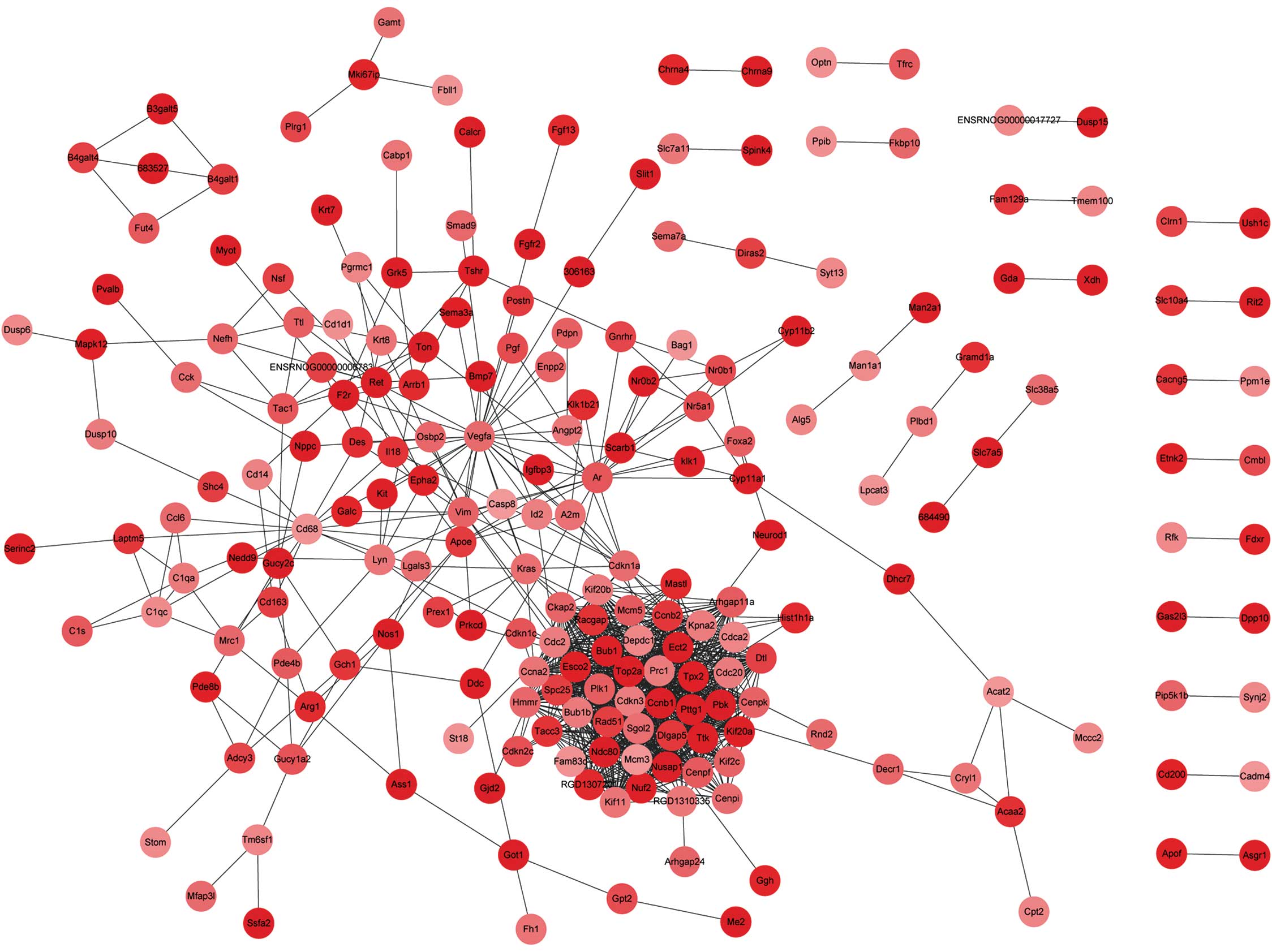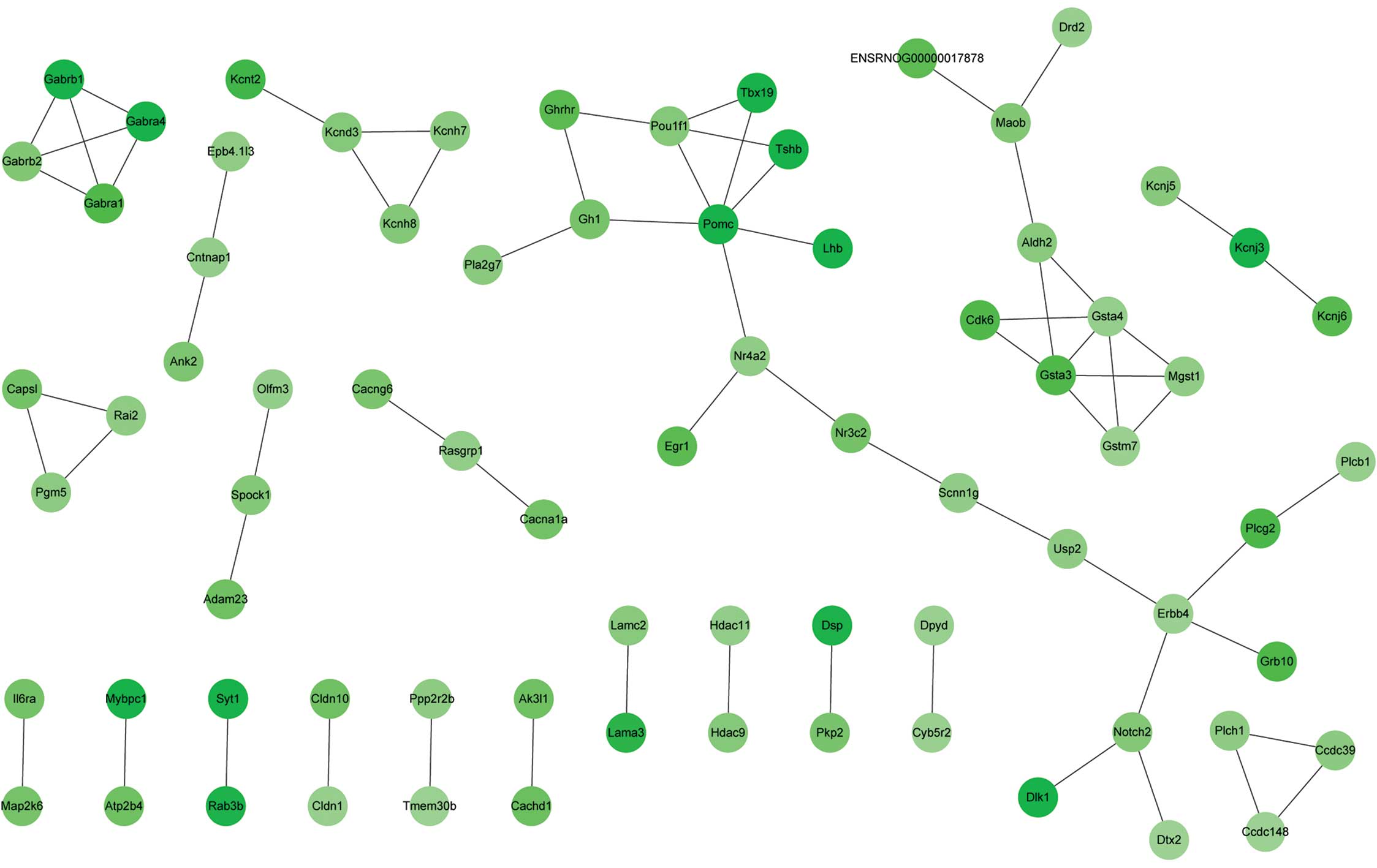|
1
|
Chesnokova V and Melmed S: Pituitary
tumour-transforming gene (PTTG) and pituitary senescence. Horm Res.
71(Suppl 2): 82–87. 2009. View Article : Google Scholar : PubMed/NCBI
|
|
2
|
Pereira AM and Biermasz NR: Treatment of
nonfunctioning pituitary adenomas: What were the contributions of
the last 10 years? A critical view. Ann Endocrinol (Paris).
73:111–116. 2012. View Article : Google Scholar : PubMed/NCBI
|
|
3
|
Lin Y, Jiang X, Shen Y, Li M, Ma H, Xing M
and Lu Y: Frequent mutations and amplifications of the PIK3CA gene
in pituitary tumors. Endocr Relat Cancer. 16:301–310. 2009.
View Article : Google Scholar : PubMed/NCBI
|
|
4
|
Vortmeyer AO, Glasker S, Mehta GU,
Abu-Asab MS, Smith JH, Zhuang Z, Collins MT and Oldfield EH:
Somatic GNAS mutation causes widespread and diffuse pituitary
disease in acromegalic patients with McCune-Albright syndrome. J
Clin Endocrinol Metab. 97:2404–2413. 2012. View Article : Google Scholar : PubMed/NCBI
|
|
5
|
Vandeva S, Tichomirowa MA, Zacharieva S,
Daly AF and Beckers A: Genetic factors in the development of
pituitary adenomas. Endocr Dev. 17:121–133. 2010. View Article : Google Scholar : PubMed/NCBI
|
|
6
|
Mezzomo LC, Gonzales PH, Pesce FG,
Kretzmann Filho N, Ferreira NP, Oliveira MC and Kohek MB:
Expression of cell growth negative regulators MEG3 and GADD45γ is
lost in most sporadic human pituitary adenomas. Pituitary.
15:420–427. 2012. View Article : Google Scholar : PubMed/NCBI
|
|
7
|
Michaelis KA, Knox AJ, Xu M,
Kiseljak-Vassiliades K, Edwards MG, Geraci M,
Kleinschmidt-DeMasters BK, Lillehei KO and Wierman ME:
Identification of growth arrest and DNA-damage-inducible gene beta
(GADD45beta) as a novel tumor suppressor in pituitary gonadotrope
tumors. Endocrinology. 152:3603–3613. 2011. View Article : Google Scholar : PubMed/NCBI
|
|
8
|
Farrell WE: Epigenetic mechanisms of
tumorigenesis. Horm Metab Res. 37:361–368. 2005. View Article : Google Scholar : PubMed/NCBI
|
|
9
|
Ezzat S: Epigenetic control in pituitary
tumors. Endocr J. 55:951–957. 2008. View Article : Google Scholar : PubMed/NCBI
|
|
10
|
Melmed S: Pathogenesis of pituitary
tumors. Nat Rev Endocrinol. 7:257–266. 2011. View Article : Google Scholar : PubMed/NCBI
|
|
11
|
Cheunsuchon P, Zhou Y, Zhang X, Lee H,
Chen W, Nakayama Y, Rice KA, Tessa Hedley-Whyte E, Swearingen B and
Klibanski A: Silencing of the imprinted DLK1-MEG3 locus in human
clinically nonfunctioning pituitary adenomas. Am J Pathol.
179:2120–2130. 2011. View Article : Google Scholar : PubMed/NCBI
|
|
12
|
D'angelo D, Palmieri D, Mussnich P, Roche
M, Wierinckx A, Raverot G, Fedele M, Croce CM, Trouillas J, Fusco
A, et al: Altered microRNA expression profile in human pituitary GH
adenomas: Down-regulation of miRNA targeting HMGA1, HMGA2 and E2F1.
J Clin Endocrinol Metab. 97:2011–3482. 2012. View Article : Google Scholar
|
|
13
|
Lee M, Marinoni I, Irmler M, Psaras T,
Honegger JB, Beschorner R, Anastasov N, Beckers J, Theodoropoulou
M, Roncaroli F, et al: Transcriptome analysis of MENX-associated
rat pituitary adenomas identifies novel molecular mechanisms
involved in the pathogenesis of human pituitary gonadotroph
adenomas. Acta Neuropathol. 126:137–150. 2013. View Article : Google Scholar : PubMed/NCBI
|
|
14
|
Irizarry RA, Hobbs B, Collin F,
Beazer-Barclay YD, Antonellis KJ, Scherf U and Speed TP:
Exploration, normalization and summaries of high density
oligonucleotide array probe level data. Biostatistics. 4:249–264.
2003. View Article : Google Scholar : PubMed/NCBI
|
|
15
|
Carvalho BS and Irizarry RA: A framework
for oligonucleotide microarray preprocessing. Bioinformatics.
26:2363–2367. 2010. View Article : Google Scholar : PubMed/NCBI
|
|
16
|
Smyth GK: Linear models and empirical
bayes methods for assessing differential expression in microarray
experiments. Stat Appl Genet Mol Biol. 3:2004.PubMed/NCBI
|
|
17
|
Benjamini Y and Hochberg Y: Controlling
the false discovery rate: A practical and powerful approach to
multiple testing. J R Stat Soc Ser B. 57:289–300. 1995.
|
|
18
|
da Huang W, Sherman BT and Lempicki RA:
Systematic and integrative analysis of large gene lists using DAVID
bioinformatics resources. Nat Protoc. 4:44–57. 2008. View Article : Google Scholar
|
|
19
|
Huang DW, Sherman BT and Lempicki RA:
Bioinformatics enrichment tools: Paths toward the comprehensive
functional analysis of large gene lists. Nucleic Acids Res.
37:1–13. 2009. View Article : Google Scholar : PubMed/NCBI
|
|
20
|
Von Mering C, Huynen M, Jaeggi D, Schmidt
S, Bork P and Snel B: STRING: A database of predicted functional
associations between proteins. Nucleic Acids Res. 31:258–261. 2003.
View Article : Google Scholar : PubMed/NCBI
|
|
21
|
Kohl M, Wiese S and Warscheid B:
Cytoscape: Software for visualization and analysis of biological
networks. Methods Mol Biol. 696:291–303. 2013. View Article : Google Scholar
|
|
22
|
He X and Zhang J: Why do hubs tend to be
essential in protein networks? PLoS genetics. 2:e882006. View Article : Google Scholar : PubMed/NCBI
|
|
23
|
Zhang X, Horwitz GA, Prezant TR, Valentini
A, Nakashima M, Bronstein MD and Melmed S: Structure, expression
and function of human pituitary tumor-transforming gene (PTTG). Mol
Endocrinol. 13:156–166. 1999. View Article : Google Scholar : PubMed/NCBI
|
|
24
|
Chen L, Puri R, Lefkowitz EJ and Kakar SS:
Identification of the human pituitary tumor transforming gene
(hPTTG) family: Molecular structure, expression and chromosomal
localization. Gene. 248:41–50. 2000. View Article : Google Scholar : PubMed/NCBI
|
|
25
|
Quereda V and Malumbres M: Cell cycle
control of pituitary development and disease. J Mol Endocrinol.
42:75–86. 2009. View Article : Google Scholar : PubMed/NCBI
|
|
26
|
Yu R, Ren SG, Horwitz GA, Wang Z and
Melmed S: Pituitary tumor transforming gene (PTTG) regulates
placental JEG-3 cell division and survival: Evidence from live cell
imaging. Mol Endocrinol. 14:1137–1146. 2000. View Article : Google Scholar : PubMed/NCBI
|
|
27
|
Yu R, Lu W, Chen J, Mccabe CJ and Melmed
S: Overexpressed pituitary tumor-transforming gene causes
aneuploidy in live human cells. Endocrinology. 144:4991–4998. 2003.
View Article : Google Scholar : PubMed/NCBI
|
|
28
|
Zhang X, Horwitz GA, Heaney AP, Nakashima
M, Prezant TR, Bronstein MD and Melmed S: Pituitary tumor
transforming gene (PTTG) expression in pituitary adenomas. J Clin
Endocr Metab. 84:761–767. 1999. View Article : Google Scholar : PubMed/NCBI
|
|
29
|
Zur A and Brandeis M: Securin degradation
is mediated by fzy and fzr and is required for complete chromatid
separation but not for cytokinesis. EMBO J. 20:792–801. 2001.
View Article : Google Scholar : PubMed/NCBI
|
|
30
|
Raverot G, Wierinckx A, Dantony E, Auger
C, Chapas G, Villeneuve L, Brue T, Figarella-Branger D, Roy P,
Jouanneau E, et al: Prognostic factors in prolactin pituitary
tumors: Clinical, histological and molecular data from a series of
94 patients with a long postoperative follow-up. J Clin Endocr
Metab. 95:1708–1716. 2010. View Article : Google Scholar : PubMed/NCBI
|
|
31
|
Leone V, Langella C, D'Angelo D, Mussnich
P, Wierinckx A, Terracciano L, Raverot G, Lachuer J, Rotondi S,
Jaffrain-Rea ML, et al: Mir-23b and miR-130b expression is
downregulated in pituitary adenomas. Mol Cell Endocrinol. 390:1–7.
2014. View Article : Google Scholar : PubMed/NCBI
|
|
32
|
Yoshida D, Nomura R and Teramoto A:
Signalling pathway mediated by CXCR7, an alternative chemokine
receptor for stromal-cell derived factor-1α, in AtT20 mouse
adrenocorticotrophic hormone-secreting pituitary adenoma cells. J
Neuroendocrinol. 21:481–488. 2009. View Article : Google Scholar : PubMed/NCBI
|
|
33
|
Yu R, Heaney AP, Lu W, Chen J and Melmed
S: Pituitary tumor transforming gene causes aneuploidy and
p53-dependent and p53-independent apoptosis. J Biol Chem.
275:36502–36505. 2000. View Article : Google Scholar : PubMed/NCBI
|
|
34
|
Hamid T and Kakar SS: PTTG/securin
activates expression of p53 and modulates its function. Mol Cancer.
3:182004. View Article : Google Scholar : PubMed/NCBI
|
|
35
|
Thapar K, Scheithauer BW, Kovacs K,
Pernicone PJ and Laws ER Jr: p53 expression in pituitary adenomas
and carcinomas: Correlation with invasiveness and tumor growth
fractions. Neurosurgery. 38:765–770. 1996. View Article : Google Scholar : PubMed/NCBI
|
|
36
|
Mccabe C, Khaira J, Boelaert K, Heaney AP,
Tannahill LA, Hussain S, Mitchell R, Olliff J, Sheppard MC,
Franklyn JA and Gittoes NJ: Expression of pituitary tumour
transforming gene (PTTG) and fibroblast growth factor-2 (FGF-2) in
human pituitary adenomas: Relationships to clinical tumour
behaviour. Clin Endocrinol (Oxf). 58:141–150. 2003. View Article : Google Scholar : PubMed/NCBI
|
|
37
|
Pei L: Identification of c-myc as a
down-stream target for pituitary tumor-transforming gene. J Biol
Chem. 276:8484–8491. 2001. View Article : Google Scholar : PubMed/NCBI
|
|
38
|
End K, Gamel-Didelon K, Jung H, Tolnay M,
Lüdecke D, Gratzl M and Mayerhofer A: Receptors and sites of
synthesis and storage of gamma-aminobutyric acid in human pituitary
glands and in growth hormone adenomas. Am J Clin Pathol.
124:550–558. 2005. View Article : Google Scholar : PubMed/NCBI
|
|
39
|
Israel J, Dufy B, Gourdji D and Vincent J:
Effects of GABA on electrical properties of cultured rat pituitary
tumor cells: An intracellular recording study. Life Sci.
29:351–359. 1981. View Article : Google Scholar : PubMed/NCBI
|
|
40
|
Cohen LE, Wondisford FE and Radovick S:
Role of Pit-1 in the gene expression of growth hormone, prolactin
and thyrotropin. Endocrinol Metab Clin North Am. 25:523–540. 1996.
View Article : Google Scholar : PubMed/NCBI
|
|
41
|
Quentien MH, Barlier A, Franc JL,
Pellegrini I, Brue T and Enjalbert A: Pituitary transcription
factors: From congenital deficiencies to gene therapy. J
Neuroendocrinol. 18:633–642. 2006. View Article : Google Scholar : PubMed/NCBI
|
|
42
|
Pellegrini I, Roche C, Quentien MH,
Ferrand M, Gunz G, Thirion S, Bagnis C, Enjalbert A and Franc JL:
Involvement of the pituitary-specific transcription factor pit-1 in
somatolactotrope cell growth and death: An approach using
dominant-negative pit-1 mutants. Mol Endocrinol. 20:3212–3227.
2006. View Article : Google Scholar : PubMed/NCBI
|
|
43
|
Millington GW: Proopiomelanocortin (POMC):
The cutaneous roles of its melanocortin products and receptors.
Clin Exp Dermatol. 31:407–412. 2006. View Article : Google Scholar : PubMed/NCBI
|
|
44
|
Stefaneanu L, Kovacs K, Horvath E and
Lloyd RV: In situ hybridization study of pro-opiomelanocortin
(POMC) gene expression in human pituitary corticotrophs and their
adenomas. Virchows Arch A Pathol Anat Histopathol. 419:107–113.
1991. View Article : Google Scholar : PubMed/NCBI
|
















